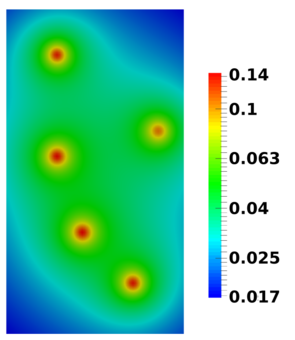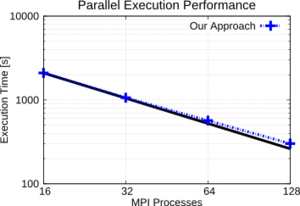Single Wave Package - 5 Point Charges - All Reflective Boundary Conditions
This simulation investigates a time-dependent, two-dimensional problem (rectangular simulation domain, spatial dimensions are 70 nm x 128 nm). The total number of particles is limited to 32⋅107 particles; the simulation is initialized with 3⋅103 particles. Reflective boundary conditions are used for all boundaries, meaning that no particles leave the simulation domain. The coherence length is 30 nm and the lattice temperature is 300 K.The system is simulated for 200fs using a 0.5 fs time step.
 |
 |
Density & Particle Evolution
Interpretation
The simulation illustrates typical features of the Wigner particle sign method. A quantum state represented by a minimal uncertainty wave packet evolves into a large simulation domain 70x128nm with point charges which represent scattering centers as they destroy the integrity of the packet. Conditions for coherent evolution are ensured by the reflecting domain boundaries and by switching off the phonon scattering. The physical density obtained by a subtraction of the numbers of positive and negative particles per spatial cell is shown in the left part of the video. Interference between the separated parts of the electron state begins during the second half of the evolution, as demonstrated by the fringes in the electron distribution. The method is capable to maintain coherent evolution in such a large simulation domain, which may be additionally demonstrated by simulations based on inversion of the time direction. The right part of the video depicts the numerical density, given by the sum of the numbers of positive and negative particles per spatial cell. The whole simulation domain is filled by particles despite that in many regions the physical density is negligible, showing that the positive and negative counterparts compensate each other. This leads to large numerical efforts and the need for parallel computation approaches.
Parallel Execution Performance
 |
The simulation was conducted on the VSC-2 supercomputer. One VSC-2 computational node provides 16 cores (two 8-core AMD Opteron Magny Cours 6132HE 2.2 GHz) and 32 GB of system memory; the nodes are connected via an InfiniBand QDR network.
The speedup offers an almost perfect, linear parallel scalability. For this setup, a simulation which would otherwise take around 9.3 hours (extrapolated, assuming linear scaling relative to 16 MPI processes), takes about 35 minutes when using 16 MPI processes or around 5 minutes when using 128 MPI processes.

